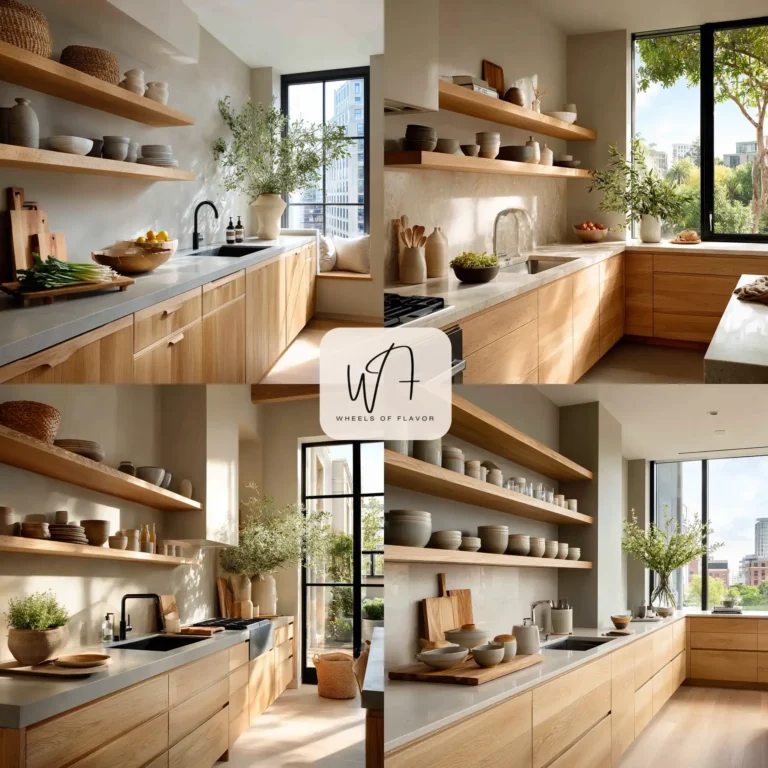The Japandi style kitchen blends the serene minimalism of Japanese design with the cozy functionality of Scandinavian aesthetics. This fusion creates a timeless, elegant, and practical space that feels both modern and inviting. If you’re dreaming of a kitchen that balances simplicity, warmth, and sophistication, the Japandi style is your answer. In this article, we’ll explore 11 stunning ideas to help you craft the perfect Japandi style kitchen, complete with practical tips and inspiration to elevate your home.
Table of Contents
What Is a Japandi Style Kitchen?
A Japandi style kitchen combines the clean lines and natural materials of Japanese design with the warm, functional elements of Scandinavian interiors. The term “Japandi” is a portmanteau of “Japanese” and “Scandi,” reflecting a harmonious blend of both cultures’ design philosophies. This style emphasizes minimalism, natural textures, neutral color palettes, and purposeful functionality, making it ideal for kitchens where form meets function.
Key characteristics of a Japandi style kitchen include:
- Neutral tones: Think soft whites, warm beiges, and muted grays.
- Natural materials: Wood, stone, and bamboo dominate the aesthetic.
- Minimalist design: Clean lines, uncluttered surfaces, and intentional decor.
- Functional beauty: Every item serves a purpose while contributing to the overall look.
Ready to bring this aesthetic into your home? Let’s dive into 11 transformative ideas for creating your dream Japandi style kitchen.
1. Embrace a Neutral Color Palette
A hallmark of the Japandi style kitchen is its soothing, neutral color scheme. Opt for soft whites, warm grays, or earthy beiges for walls, cabinets, and countertops. These hues create a calming atmosphere while allowing natural materials to shine. For a touch of contrast, incorporate subtle accents like matte black hardware or muted green plants.
Pro Tip: Use a monochromatic palette with varying shades of the same color to add depth without overwhelming the space.
2. Incorporate Natural Wood Elements
Wood is a cornerstone of Japandi design, bringing warmth and texture to the kitchen. Choose light-toned woods like oak, ash, or birch for cabinets, open shelves, or flooring. For a Japanese-inspired touch, consider darker woods like walnut for smaller accents, such as drawer pulls or a cutting board.
For inspiration on using natural materials, check out this guide to sustainable kitchen design from Architectural Digest.
3. Opt for Minimalist Cabinetry
In a Japandi style kitchen, cabinetry should be sleek and unadorned. Flat-panel cabinets with handle-less designs or simple, understated hardware keep the look clean and modern. Avoid ornate details or excessive embellishments to maintain the minimalist aesthetic.
Pro Tip: Consider open shelving to display carefully curated ceramics or glassware, enhancing the airy feel of the space.

4. Use Natural Stone or Ceramic Countertops
Countertops in a Japandi style kitchen should feel organic and timeless. Materials like granite, quartz, or ceramic in muted tones work beautifully. For a bold yet subtle statement, consider a matte-finish countertop with a slight texture to add depth without disrupting the minimalist vibe.
5. Add Functional Lighting
Lighting in a Japandi kitchen should be both practical and aesthetic. Pendant lights with simple, organic shapes—think woven rattan or matte ceramic—work well above islands or dining areas. Under-cabinet lighting can enhance functionality while maintaining a clean look.
Pro Tip: Choose warm-toned bulbs to create a cozy ambiance that aligns with Scandinavian hygge principles.
6. Incorporate Textured Textiles
While Japandi design is minimalist, it’s not cold or sterile. Introduce soft textiles like linen or cotton in neutral tones for curtains, table runners, or seat cushions. These elements add warmth and comfort, balancing the sleek surfaces of the kitchen.
For more ideas on incorporating textures, explore our Styles and Trends category for inspiration.
7. Focus on Functional Decor
In a Japandi style kitchen, every item should serve a purpose. Choose decor that doubles as functional pieces, such as handcrafted ceramic bowls, wooden cutting boards, or woven baskets for storage. Avoid clutter by selecting only a few high-quality, meaningful items.
8. Integrate Indoor Plants
Plants bring life and a touch of nature to a Japandi style kitchen. Opt for low-maintenance options like bonsai, pothos, or snake plants in simple ceramic pots. Place them on open shelves, countertops, or near windows to enhance the organic feel of the space.
9. Create a Clutter-Free Space
A clutter-free environment is essential for achieving the serene aesthetic of a Japandi style kitchen. Invest in smart storage solutions like pull-out drawers, hidden compartments, or built-in organizers to keep surfaces clean and tidy.
Pro Tip: Use woven baskets or wooden boxes to store smaller items, adding texture while maintaining functionality.
10. Blend Japanese and Scandinavian Furniture
Furniture in a Japandi kitchen should feel both modern and timeless. A wooden dining table with clean lines paired with Scandinavian-inspired chairs in neutral upholstery creates a cohesive look. For bar stools, consider designs with minimalist metal frames and wooden seats.
11. Add Subtle Cultural Touches
Incorporate small nods to Japanese and Scandinavian cultures to elevate your Japandi style kitchen. A Japanese-inspired tea set, a Scandinavian wool throw, or a handcrafted ceramic vase can add personality without overwhelming the minimalist aesthetic.
For more inspiration on blending cultural elements, visit Dwell’s guide to Japandi design.
FAQs About Japandi Style Kitchens
What is the Japandi style in kitchen design?
The Japandi style combines Japanese minimalism and Scandinavian functionality, characterized by neutral colors, natural materials, and clean lines for a serene, practical kitchen.
How can I make my kitchen look Japandi?
Focus on neutral tones, natural wood, minimalist cabinetry, and functional decor. Add plants and textured textiles for warmth, and keep surfaces clutter-free.
What materials are best for a Japandi style kitchen?
Use light woods like oak or ash, natural stone or ceramic for countertops, and simple ceramics for decor. Avoid overly ornate or synthetic materials.
Is Japandi style expensive to achieve?
Not necessarily! You can achieve a Japandi look by focusing on affordable natural materials, decluttering, and selecting a few high-quality, timeless pieces.
Where can I find more kitchen design inspiration?
Explore our Styles and Trends category for more ideas, or check out high-authority blogs like Apartment Therapy for additional inspiration.
Conclusion
Creating a Japandi style kitchen is about blending simplicity, functionality, and beauty. By incorporating neutral tones, natural materials, and minimalist design principles, you can craft a space that feels both modern and timeless. Use these 11 ideas as a starting point to transform your kitchen into a serene, inviting haven. For more design inspiration, dive into our Styles and Trends category and start planning your dream kitchen today!

